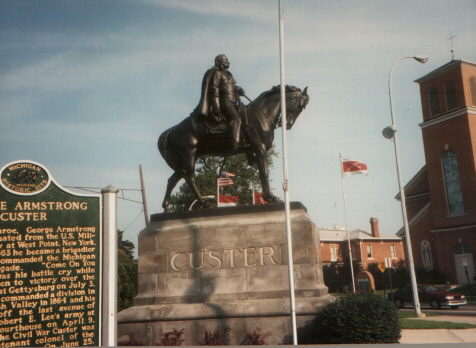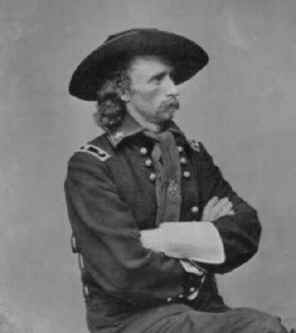|
|
|
|
|
George Armstrong Custer |
| George Armstrong Custer was born on December 5th, 1839 in New-Rumley, Ohio. His parents were Emanuel and Maria Custer. George had three brothers and one sister. Custer had many nicknames. To his family members he was known as "Autie" because of his first attempts to say Armstrong. To the Indians he was known as "Longhair". Many of the officers in the army called him "Boy General". | |
| Custer was known as "Boy General" because he was the youngest man ever to become a general. George went to West Point Academy. Custer's lifestyle had to change because he almost got kicked out of the Academy but someone secretly changed the demerits so he would have less. Autie graduated at the bottom of his class in 1861. Custer reported for duty in Washington. After General McClellan's retirement, Custer was returned to his regiment as lieutenant. He was appointed to general of volunteers. After that he was a captain then on to Lieutenant Colonel, and lastly at age 23 he became a general. General Custer married Elizabeth Bacon in February of 1864. | |
|
1876 Campaign Custer under the command of General Alfred Terry helped round up Sioux and Cheyenne Indians. Custer was sent to find an Indian village. After rounding them up Custer left Fort Hayes to see his wife. The United States Supreme Court found General Custer guilty of desertion and suspended him for a year from the army. |
|
|
Battle of Little Bighorn The Battle of Little Big Horn, also known as Custer's Last Stand, took place on June 25th, 1876, in the Montana Territory. Custer left the Rosebud River on June 22nd with two companies of the 7th Cavalry. When Gen. Custer came upon Sitting Bull's camp he estimated that there were 1000 Indian Warriors but in fact there were 4000. Custer divided his regiment into three groups. Captain Frederick Benteen was assigned to the south of the camp with 125 soldiers. Major Marcus Reno was to go across the Little Big Horn with 115 soldiers. Custer had 264 soldiers and he headed east of the Little Bighorn. Outnumbered ten to one Custer attacked. The long, bloody battle resulted in Custer's entire cavalry being wiped out including Custer's brother who was serving with him. The army lost 507 men that day. Surprisingly Custer's body was not mutilated like the rest of them. The Indian chiefs, Sitting Bull, Crazy Horse and Gall decided to let the Indian women do what they wanted to him. He ended up with holes in his ears so that in the after life he could hear the Indian women and what they told him. Because Reno was held up on a hill the whole day, many blame him for the losses and for not helping Custer and Benteen and their cavalries. General Gibbon's cavalry didn't come to Reno's aid until the battle was over so they couldn't do anything. After the battle Generals William T. Sherman and Phil Sheridan said that General Custer was " Rashly imprudent to attack such a large number of Indians" referring to Sitting Bull's force of 4000. The remaining Indians were put in jail as Prisoners of War. Custer was buried at West Point on October 10, 1877. He was only 37 when he died in the Battle of Little Bighorn. A statue of General George Custer was erected in 1879, but wife Libby didn't think it looked like him, so she made them take it down. The whereabouts of it are still unknown.
|
|

|
This is a statue of General Custer on his horse. |

